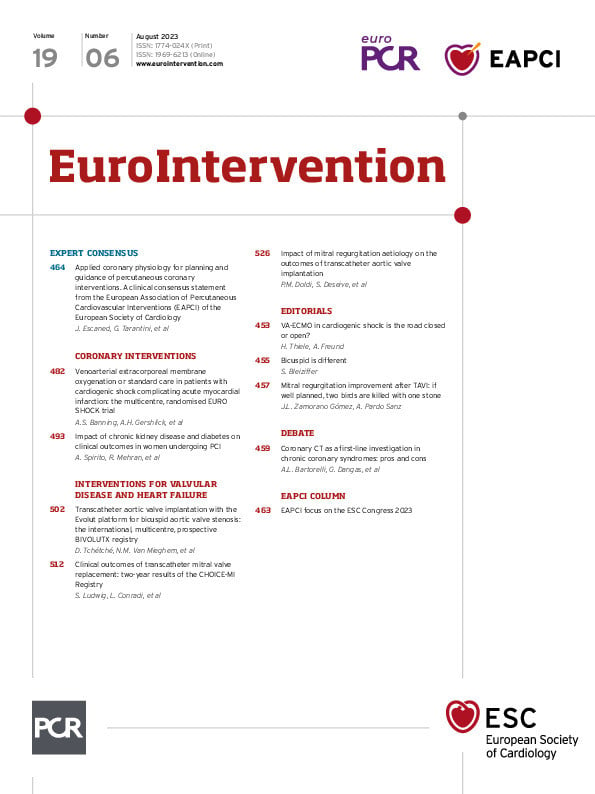Bicuspid aortic valve (BAV) stenosis is still a challenge for transcatheter aortic valve implantation (TAVI) today. In this issue of EuroIntervention, Tchétché et al present the results of the BIVOLUTX registry, adding prospective multicentre outcome data to the current knowledge and evaluating sizing methods in 149 patients with BAV treated with a self-expanding platform1. The primary endpoint was valve performance according to Valve Academic Research Consortium (VARC)-3 criteria; mortality was a secondary endpoint. With 142/149 patients having reached the primary endpoint of valve performance, and a 30-day and 1-year cardiac death rate of 2.6% and 11%, respectively, the authors conclude a favourable performance and good clinical outcomes; notably, sizing methodology had no impact. This study had no core screening committee, and patient selection was performed by the experienced local Heart Teams.
The big question behind the scientific evaluation of TAVI outcomes in bicuspid aortic stenosis is whether we will be able to treat all patients with TAVI in the future.
Some of the concerns and uncertainties of TAVI in BAV stenosis are elliptical expansion and its impact on durability, paravalvular leakages (PVL), annular rupture, the correct mode of sizing, stroke, pacemaker rate, and size limitation. In a post-TAVI computed tomography (CT) evaluation of a subset of 101 patients, the BIVOLUTX registry data show, for the first time, that the ellipticity remained unchanged compared to the preprocedural measurements. Yet, it is not possible to conclude anything from this regarding durability. Recent data, in any case, do not support safety or outcome concerns in patients with an elliptical annulus2.
In recent studies on BAV TAVI, more than mild PVL seems infrequent, with no patients presenting with more than moderate PVL at 30 days in the BIVOLUTX registry. The authors conclude that the features of the Evolut (Medtronic) platform, with repositionability and pericardial wrap available in the latest Evolut generation, contribute to favourable PVL rates. In addition to the technical improvements with contemporary prosthesis types, there is a better understanding worldwide of how to select patients. TAVI implanters have learned to identify high-risk anatomies, such as if excessive leaflet calcification or calcified raphe is present,3 and to tailor the procedure to these conditions. This selection bias is probably reflected in the fact that 206 BAV patients were identified during screening for BIVOLUTX, but only 152 were included in the registry.
Conversion to surgery for any intracardiac injury is still numerically more frequent in BAV stenosis than tricuspid aortic valve anatomy but remains rare (n=2 patients in BIVOLUTX). Again, the identification of high-risk anatomies and appropriate decision-making for the procedure by an experienced Heart Team is key.
The authors adequately address the borderline high stroke rate in the BIVOLUTX registry (4.7% disabling stroke rate at 1 year), which could be linked to the general risk profile of the patients as well as to the calcium burden found in BAV anatomies3. This needs special attention, particularly when younger patients with BAV are treated, and the efficacy of embolic protection may need to be re-evaluated.
With increasing knowledge about patient selection and understanding of CT details in BAV stenosis, the question of the utility of a randomised controlled trial (RCT) comparing TAVI to surgical aortic valve replacement (SAVR) in BAV patients arises. It is important to understand that in surgery any amount and distribution of calcium can be safely removed before accurate valve implantation, and even a type II anatomy can be treated with equal results. There is no risk of rupture. There is also no size limitation, as a prosthesis can be sutured with no PVL even in very large annuli. Surgeons are aware that meticulous removal of all calcium particles is important because of the risk of stroke. Retrospective comparative data of TAVI versus SAVR in BAV stenosis suffer from substantial differences in baseline characteristics with the older and sicker patients found in the TAVI populations. In a meta-analysis, PVL rates and pacemaker rates were higher after TAVI in BAV, while stroke and survival were similar; outcomes in terms of renal, haemostatic, and respiratory complications were better for TAVI4.
In summary, the BIVOLUTX data add to the evidence that TAVI in BAV stenosis can be performed with favourable results with contemporary prostheses and tailored procedure details. The concerns about PVL, stroke and pacemakers are all subjects that could be addressed with an RCT. Judicious patient selection by an experienced Heart Team will continue to be required.
Conflict of interest statement
S. Bleiziffer receives speaker fees from Abbott, Boston Scientific, Edwards Lifesciences, and Medtronic.

